-

新人教版高中英语选修2Unit 3 Using langauge-Listening教学设计
1. How is Hunan cuisine somewhat different from Sichuan cuisine?The heat in Sichuan cuisine comes from chilies and Sichuan peppercorns. Human cuisine is often hotter and the heat comes from just chilies.2.What are the reasons why Hunan people like spicy food?Because they are a bold people. But many Chinese people think that hot food helps them overcome the effects of rainy or wet weather.3.Why do so many people love steamed fish head covered with chilies?People love it because the meat is quite tender and there are very few small bones.4.Why does Tingting recommend bridge tofu instead of dry pot duck with golden buns?Because bridge tofu has a lighter taste.5 .Why is red braised pork the most famous dish?Because Chairman Mao was from Hunan, and this was his favorite food.Step 5: Instruct students to make a short presentation to the class about your choice. Use the example and useful phrases below to help them.? In groups of three, discuss what types of restaurant you would like to take a foreign visitor to, and why. Then take turns role-playing taking your foreign guest to the restaurant you have chosen. One of you should act as the foreign guest, one as the Chinese host, and one as the waiter or waitress. You may start like this:? EXAMPLE? A: I really love spicy food, so what dish would you recommend?? B: I suggest Mapo tofu.? A: Really ? what's that?

新人教版高中英语选修2Unit 4 Learning about Language教学设计
This section guides students to pay attention to the typical context of vocabulary use, helps students accumulate vocabulary around the key vocabulary of this unit, and uses the learned words and word chunks in different contexts to deeply understand their meaning and usage, so as to achieve the purpose of review and consolidation.The teaching design activities aim to guide students to pay attention to the typical context in which the target vocabulary is used, as well as the common vocabulary used in collocation, so that students can complete the sentence with correct words. In terms of vocabulary learning strategies, this unit focuses on cultivating students' ability to pay attention to collocation of words and to use word blocks to express meaning.For vocabulary learning, it is not enough just to know the meaning of a single word, but the most important thing is to master the common collocations of words, namely word blocks.Teachers should timely guide students to summarize common vocabulary collocation, such as verb and noun collocation, verb and preposition collocation, preposition and noun collocation, and so on.1. Guide students to understand and consolidate the meaning and usage of the vocabulary in the context, 2. Guide the students to use the unit topic vocabulary in a richer context3. Let the students sort out and accumulate the accumulated vocabulary, establishes the semantic connection between the vocabulary,4. Enable students to understand and master the vocabulary more effectivelyGuiding the Ss to use unit topic words and the sentence patterns in a richer context.

新人教版高中英语选修2Unit 5 Learning about Language教学设计
The purpose of this section of vocabulary exercises is to consolidate the key words in the first part of the reading text, let the students write the words according to the English definition, and focus on the detection of the meaning and spelling of the new words. The teaching design includes use English definition to explain words, which is conducive to improving students' interest in vocabulary learning, cultivating their sense of English language and thinking in English, and making students willing to use this method to better grasp the meaning of words, expand their vocabulary, and improve their ability of vocabulary application. Besides, the design offers more context including sentences and short passage for students to practice words flexibly.1. Guide students to understand and consolidate the meaning and usage of the vocabulary in the context, 2. Guide the students to use the unit topic vocabulary in a richer context3. Let the students sort out and accumulate the accumulated vocabulary, establishes the semantic connection between the vocabulary,4. Enable students to understand and master the vocabulary more effectivelyGuiding the Ss to use unit topic words and the sentence patterns in a richer context.Step1: Read the passage about chemical burns and fill in the blanks with the correct forms of the words in the box.

新人教版高中英语选修2Unit 5 Reading and thinking教学设计
The theme of this activity is to learn the first aid knowledge of burns. Burns is common in life, but there are some misunderstandings in manual treatment. This activity provides students with correct first aid methods, so as not to take them for granted in an emergency. This section guides students to analyze the causes of scald and help students avoid such things. From the perspective of text structure and collaborative features, the text is expository. Expository, with explanation as the main way of expression, transmits knowledge and information to readers by analyzing concepts and elaborating examples. This text arranges the information in logical order, clearly presents three parts of the content through the subtitle, accurately describes the causes, types, characteristics and first aid measures of burns, and some paragraphs use topic sentences to summarize the main idea, and the level is very clear.1. Guide students to understand the causes, types, characteristics and first aid methods of burns, through reading2. Enhance students’ ability to deal withburnss and their awareness of burns prevention3. Enable students to improve the ability to judge the types of texts accurately and to master the characteristics and writing techniques of expository texts.Guide students to understand the causes, types, characteristics and first aid methods of burns, through readingStep1: Lead in by discussing the related topic:1. What first-aid techniques do you know of ?CPR; mouth to mouth artificial respiration; the Heimlich Manoeuvre

新人教版高中英语选修2Unit 5 Using langauge-Listening教学设计
The theme of this section is to learn how to make emergency calls. Students should learn how to make emergency calls not only in China, but also in foreign countries in English, so that they can be prepared for future situations outside the home.The emergency telephone number is a vital hotline, which should be the most clear, rapid and effective communication with the acute operator.This section helps students to understand the emergency calls in some countries and the precautions for making emergency calls. Through the study of this section, students can accumulate common expressions and sentence patterns in this context. 1.Help students accumulate emergency telephone numbers in different countries and learn more about first aid2.Guide the students to understand the contents and instructions of the telephone, grasp the characteristics of the emergency telephone and the requirements of the emergency telephone.3.Guide students to understand the first aid instructions of the operators.4.Enable Ss to make simulated emergency calls with their partners in the language they have learned1. Instruct students to grasp the key information and important details of the dialogue.2. Instruct students to conduct a similar talk on the relevant topic.Step1:Look and discuss:Match the pictures below to the medical emergencies, and then discuss the questions in groups.
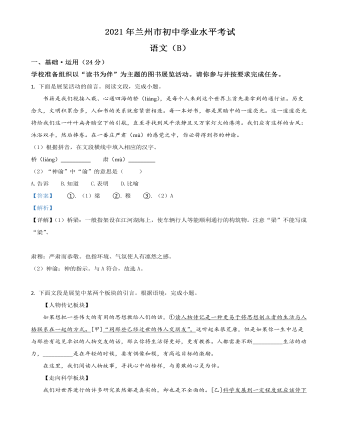
甘肃省兰州市2021年中考语文试题(B卷)(解析版)
阅读下面这首诗,完成下面小题。暮春即事周敦颐双双瓦雀行书案,点点杨花入砚池。闲坐小窗读周易,不知春去几多时。5. 请你想象“双双瓦雀行书案”描绘的画面,并将它描写出来。

甘肃省兰州市2021年中考语文试题(B卷)(原卷版)
我如获至宝。跟着父亲去学校的时候,他的学生们在教室里大声读书,我坐在门槛上,捧着书小声咕哝。跟着母亲下地干活的时候,我背着书包,坐在细瘦的田埂上,读书给花听。碰到不认识的字,就飞快地跑到母亲身边求教。哥哥在大槐树下写作业的时候,我也找根小树枝,在平整的地面上歪歪扭扭地写字。
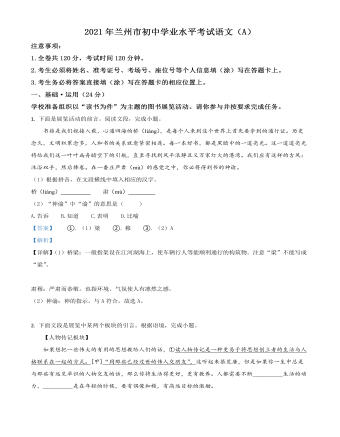
甘肃省兰州市2021年中考语文试题(A)(解析版)
阅读下面这首诗,完成下面小题。暮春即事周敦颐双双瓦雀行书案,点点杨花入砚池。闲坐小窗读周易,不知春去几多时。5. 请你想象“双双瓦雀行书案”描绘的画面,并将它描写出来。
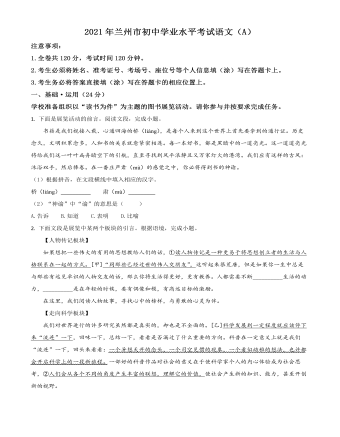
甘肃省兰州市2021年中考语文试题(A)(原卷版)
我是在下乡前两天买下《静静的顿河》的。那四本一套的书,放在书店右面那个蛮高的橱架上,我原因不明地看了它整整五年,原因不明地,总是目光就停在它那儿。整整五年,它在那个位置上没有动过,它的左边是《月亮和六便士》,所以我既记住了肖洛霍夫,也记住了毛姆。
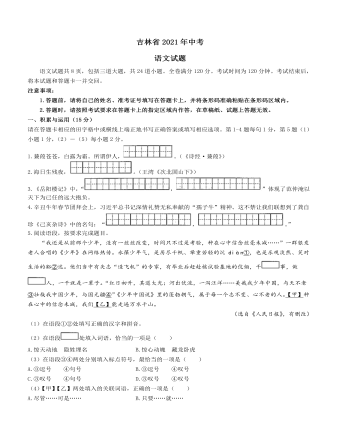
2021年吉林省中考语文真题(含答案)(原卷版)
出佛手园,远处有山,山中有岚,有云。岚清,云白,绸缎一般,棉花一般,曼妙而行,逍遥自在。除了爱,还有眼前这山川草木。小小人类身处自然,永不孤单。那些草木,那些动物,那些自然界中的生灵,各安其所,相处自洽。而人类,不免焦虑,屡屡焦虑,内在小宇宙紊乱,何不走到自然中,谦卑蹲下,去学习一株草、一颗露珠的宁静?

部编版语文七年级上册《纪念白求恩》教案
目标导学二:理解内容,探究结构1.文章开头对白求恩同志的介绍包含哪些内容?有于么作用?明确:他是资本主义国家中无产阶级先锋队的一员;年岁已大,壮心不已;肩负重担,奔赴前线;以身殉职,重于泰山。扣住国际主义的原则概述白求恩同志的简历,是对逝者的追忆,也是论述白求恩具有国际主义精神的事实依据。2.白求恩不远万里来到中国,他身上最本质的东西是什么么?用文中的原话回答。明确:“这是国际主义的精神,这是共产主义的精神。”2.引用“列宁主义认为”一段话的作用是什么?是为了突出白求恩同志这一精神的重要意义。作者在这里引用马列主义的观点作为自己立论的根据,这是运用论证法中的“引证法”,论述白求恩同志是伟大的国际主义战士。
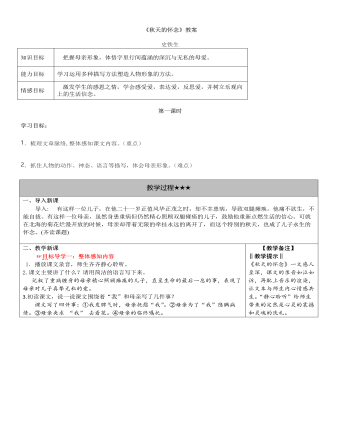
部编版语文七年级上册《秋天的怀念》教案
目标导学三:拓展理解1.几十年后,回忆起母亲,史铁生写下了这么一段话,请读一读,说说你读出了作者怎样的情感。那时的我,作为她的儿子,还太年轻,还来不及为母亲着想,我被命运击昏了头,一心以为自己是世上最不幸的一个,不知道儿子的不幸在母亲那儿总是要加倍的。她有一个长到二十岁上忽然截瘫了的儿子,这是她唯一的儿子;她情愿截瘫的是自己而不是儿子,可这事无法代替;她想,只要儿子能活下去哪怕自己去死呢也行,可她又确信一个人不能仅仅是活着,儿子得有一条路走向自己的幸福的路;而这条路呢,没有谁能保证她的儿子终于能找到——而这样的母亲,注定是世界上活得最苦的母亲。我感受到:作者对母亲的怀念、思念之情;作者对母亲的忏悔、懊悔、后悔、悔恨之情;作者对母亲的自责、内疚之情;作者自己的成长,完全理解母亲了……2.阅读课后练习四史铁生《我与地坛》中的同样是写母亲一段文字,说说它与课文在写法上有何不同。
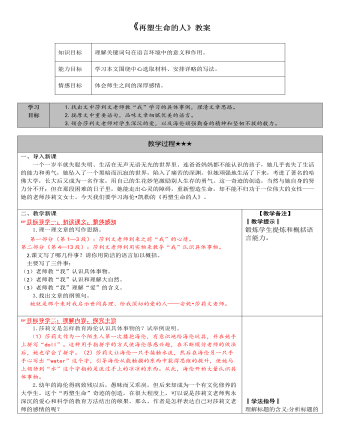
部编版语文七年级上册《再塑生命的人》教案
课文开头写道:“老师安妮·莎莉文来到我家的这一天,是我一生中最重要的一天”,在作者的心目中莎莉文老师就是光明的使者,她到来时作者这样描述自己的心情感受:“我心里无声地呼喊着:‘光明!光明!快给我光明!’恰恰正在此时,爱的光明照到了我的身上。她就是那个来对我启示世间的真理、给我深切的爱的人。”课文更多地还是通过写莎莉文老师对“我”的理解、关爱、教育的具体言行,来表达作者对莎莉文老师的感激、崇敬之情。3.文中的海伦和莎莉文老师给你留下了怎样的印象?海伦是一个好学、聪明、坚毅、情感丰富、有强烈的求知欲的女孩。莎莉文是一个爱海伦,讲究教育方法艺术,因势利导、循循善诱、抓住教育时机的出色的教育艺术家。4.如何理解标题“再塑生命的人”的含义?“再塑生命”是“重新塑造、获得生命”的意思,文中是指“爱的光明照到了我的身上”。在莎莉文老师教育下,海伦的灵魂被唤醒,再次拥有了“光明、希望、快乐和自由”。莎莉文让海伦又回到自然,理解自然,并懂得什么是“爱”。

部编版语文九年级上册《醉翁亭记》教案
一、导入新课范仲淹因参与改革被贬,于庆历六年写下《岳阳楼记》,寄托自己“先天下之忧而忧,后天下之乐而乐”的政治理想。实际上,这次改革,受到贬谪的除了范仲淹和滕子京之外,还有范仲淹改革的另一位支持者——北宋大文学家、史学家欧阳修。他于庆历五年被贬谪到滁州,也就是今天的安徽省滁州市。也是在此期间,欧阳修在滁州留下了不逊于《岳阳楼记》的千古名篇——《醉翁亭记》。接下来就让我们一起来学习这篇课文吧!【教学提示】结合前文教学,有利于学生把握本文写作背景,进而加深学生对作品含义的理解。二、教学新课目标导学一:认识作者,了解作品背景作者简介:欧阳修(1007—1072),字永叔,自号醉翁,晚年又号“六一居士”。吉州永丰(今属江西)人,因吉州原属庐陵郡,因此他又以“庐陵欧阳修”自居。谥号文忠,世称欧阳文忠公。北宋政治家、文学家、史学家,与韩愈、柳宗元、王安石、苏洵、苏轼、苏辙、曾巩合称“唐宋八大家”。后人又将其与韩愈、柳宗元和苏轼合称“千古文章四大家”。
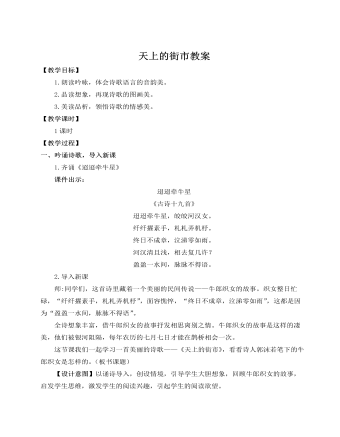
人教部编版七年级语文上册天上的街市教案
第二节:突出天上“美丽的街市”。①读第一句,语调要轻缓柔美,“我想”要稍稍拖长,重读“缥缈”和“空中”,表示强调,仿佛沉浸在离奇美妙的幻想之中。②第二句是诗人美好的愿望,“定然”和“有”要读得铿锵有力,然后提高语调,加大音量,热烈地吟诵“美丽——的(轻声)——街市”。③第三句既是进一步的想象,又是具体的描述,可降低音量,放慢速度,绘声绘色地读。④第四句是对天河的惊叹和赞美。读时语气要肯定,表示确信无疑,重读“没有”,而用清亮、柔和的拖音读“珍奇”二字,以激起人们对美丽、奇妙的天街的无限向往。第三节:突出天河中的牛郎织女。①第一句,“你看”后作较长的停顿,以表示诗人的遐想和提醒人们的注意。读“那浅浅的天河”时重音放在“天河”上,“浅浅”二字则延长字音,放慢速度,以强调“天河”之水清亮可鉴。②第二句,应用一种畅想、舒缓的语气读,读“定然”时,音量要稍大,以增强对幻想的确信。③第三句,在轻轻读过“那隔着河的”之后,要把“牛郎织女”按两个音步的节奏读得格外清楚、响亮。
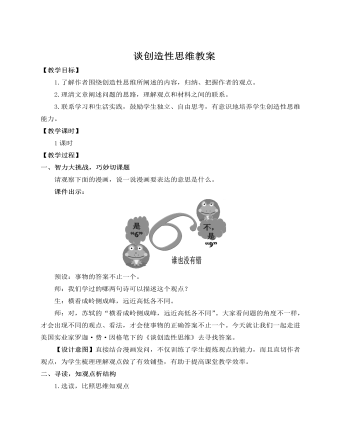
人教部编版语文九年级上册我爱这土地教案
教师:我们可以从诗歌运用“悲怆的诗句”去“反映热切的感情”角度去分析。教师指正:作为抒情的艺术,诗歌作品需要不断地强化自己的感情,以便能久久地拨动读者的心弦。这首诗中回荡着忧郁的调子,郁积着深深的忧伤。“为什么我的眼里常含泪水?/因为我对这土地爱得深沉…… ”句中交织着忧郁、悲怆之情,这种抒情基调是诗人敏感的心灵对民族苦难现实和人民悲苦生活的回应,是感情极度热切的反映。教师:我们可以从诗歌运用“强烈的对比”去“映射执着的爱”的角度去分析。教师指正:“假如我是一只鸟”全诗以这样一个出人意料的假设开头,使读者不禁发出疑问:“鸟”的形象和诗人所要歌颂的“土地”有着什么样的联系呢?这是诗人在开头留给我们的悬念。当读者为诗人不断歌唱的顽强生命力所吸引、折服时,诗篇却陡然来了一个大的转折——“我死了”,用身躯使土地肥沃,于是生前和死后形成了强烈的对比,而在这强烈的对比中一以贯之的是“鸟”对土地的执着的爱,这真是生于斯、歌于斯、葬于斯,至死不渝!至此开头的悬念也就解开了。
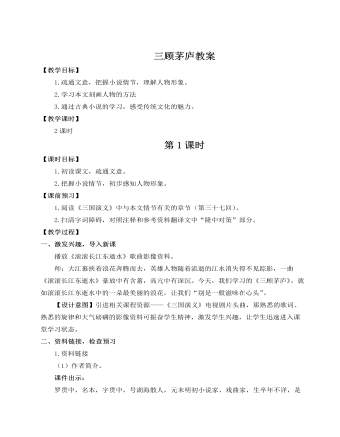
人教部编版语文九年级上册三顾茅庐教案
1.发散思维诸葛亮出山后为刘备鞠躬尽瘁,死而后已,勤勉一生,做了许多大事。关于诸葛亮的故事,你还知道多少呢?请列举出来。预设:火烧博望坡、火烧新野、舌战群儒、智激周瑜、七星坛借东风、巧布八阵图、空城计、挥泪斩马谡、七擒孟获、六出祁山、星落五丈原……2.拓展阅读布置学生课后阅读《三国演义》中相关回目(第四十、四十三、四十四、四十九、八十四、九十、九十六、一百零三回等)。【设计意图】《三国演义》中关于诸葛亮的章节很多,这样拓展,一是让已经读完《三国演义》的学生积极展示他的所读所知,二是有效激发还未读完《三国演义》这部书的同学的阅读兴趣。结束语:虽然“古今多少事,都付笑谈中”,但请同学们记住刘备对人才的尊重。尤其在日新月异的当下,创新和发展,都离不开人才,可以毫不夸张地说,得人才者得制高点,得人才者得持续发展,得人才者得最终胜利!
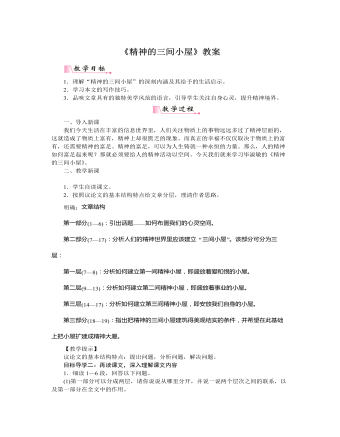
部编版语文九年级上册《精神的三间小屋》教案
(4)写第三间小屋时作者为什么说“在我们的小屋里,住着所有我们认识的人,唯独没有我们自己”?明确:这是一个信息高度发达的社会,我们能从不同渠道接受各种纷繁复杂的信息,渐渐,有的人就被这个信息社会所同化了,常常随波逐流,用他人的观点来肯定事物的价值,常常以为众人所追求的就是他们自己想要的。于是别人的思想、外在的信息代替了他们自己的思想,使自己成为缺乏思想和思考的人,所以说“唯独没有我们自己”。(5)你认为在第三间精神小屋中应该怎样“安放我们自身”呢?明确:安放自身需要思考,拥有独立的思想。(6)请你结合日常生活,说说你是否尝试过如此构建“精神的三间小屋”。【教学提示】引导学生在对“精神的三间小屋”的理解基础上来审视生活,从而达到反思生活,审视自我精神世界,建构自我精神世界的目的。

部编版语文九年级上册《我爱这土地》教案
目标导学四:赏析作品,把握诗歌艺术特色1.这首诗在结构上共分两节,请简要说说两节诗歌各有什么特点及它们之间的内在联系。明确:诗的第一节是从虚拟的视角,即从鸟儿的视角去想象,去表现鸟儿对土地的忠诚与挚爱,显得形象含蓄;第二节却换成实写的视角,即从作者自我的视角去实写自己“常含泪水的眼睛”,倾诉自己对土地的“深沉”之爱,是直抒胸臆。这样,虚境和实境的结合与对应,构筑了全诗内在完整的艺术空间;结果与原因的关联与对照,又构成了支撑全诗的内在逻辑结构。此外,从手法特点上看,第一节用的是比,是想象的境界;第二节则是直抒胸臆的写实。全诗由前面蒙太奇镜头式的画面暗示转到了后面作者的直接指点,以一个强有力的情感抒发结束了全篇,从而把注意力引到一个浓郁的情感氛围中,再一次感受到作者对土地的忠贞与挚爱。
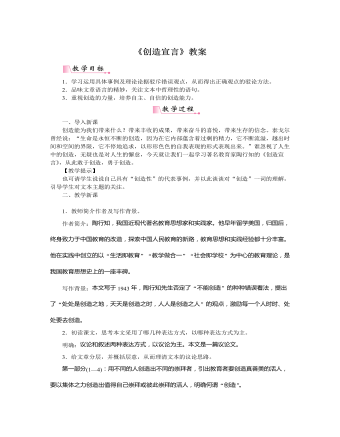
部编版语文九年级上册《创造宣言》教案
1.学习运用具体事例及理论论据驳斥错误观点,从而得出正确观点的驳论方法。2.品味文章语言的精妙,关注文本中哲理性的语句。3.重视创造的力量,培养自主、自信的创造能力。一、导入新课创造能为我们带来什么?带来丰收的成果,带来奋斗的喜悦,带来生存的信念。泰戈尔曾经说:“生命是永恒不断的创造,因为在它内部蕴含着过剩的精力,它不断流溢,越出时间和空间的界限,它不停地追求,以形形色色的自我表现的形式表现出来。”谁忽视了人生中的创造,无疑也是对人生的懈怠,今天就让我们一起学习著名教育家陶行知的《创造宣言》,从此敢于创造,勇于创造。【教学提示】也可请学生说说自己具有“创造性”的代表事例,并以此谈谈对“创造”一词的理解,引导学生对文本主题的关注。二、教学新课目标导学一:初读课文,整体感知1.教师简介作者及写作背景。




